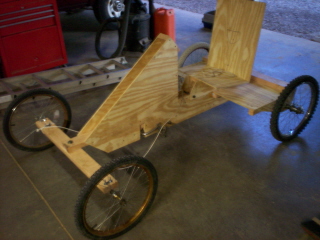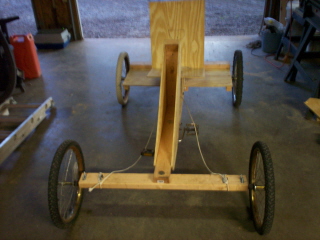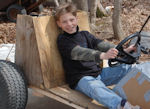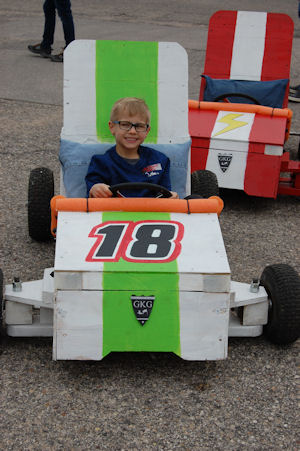 The challenge: taking two bikes and converting it into a pedal go kart. Limitations: minimal welding and spend under $50 total for the whole pedal cart.
The challenge: taking two bikes and converting it into a pedal go kart. Limitations: minimal welding and spend under $50 total for the whole pedal cart.
Limitations:
– Every day parts
– Standard plywood
– Bicycle parts
The Pedal Go Kart Chronicle
The pedal go kart started out with an idea. There’ve been a lot of customers who have been asking:
– What about the pedal go kart?
– Do you have any plans for a pedal go kart?
– Have you tried making one?
The answer to those questions is: Yes I have plans, and Yes I have tried making one. The answer to the success story, that is another matter however, and I want to discuss the issues that you will run into when you make a pedal go kart.
 A pedal go kart has numerous challenges and may fall into the following areas:
A pedal go kart has numerous challenges and may fall into the following areas:
– Steering
– The drive system
– The braking system
As is discussed in previous articles the steering system can be a challenge especially if you’re using a carriage style bogey system.
The reason why there is a challenge is because of the stability issues that you run into with the carriage style steering. If the carriage style steering is not supported properly it can twist over and you can have a rollover situation very easily.
The bicycle go kart that we developed has stability issues basically because it is so high off the ground and because of the bogey steering system.
The center of gravity is high off the ground making it prone to rollover, especially if you are doing high-speed maneuvers. This go kart is not to be used on hills because it is too unstable.
The instability is because of the high center of gravity and because of the steering issues. Primarily because the braking has not been perfected.
The drive system has numerous challenges to it first be strengthened or forces required to push the go kart. A one-to-one drive is recommended, otherwise the forces required to move the go kart are too great and the pedal mounting system becomes quite a challenge. In order to keep the weight down a one to one ratio is recommended.
Another downside to the total system is that it does not free wheel when you are coasting. This can be quite unnerving because the pedals will continue to move with large forces and can cause you to lose your footing on the pedals. Normally when we ride a bicycle we are a customed to allowing the bike to free wheel, however the mechanism to make the freewheeling occur is contained inside of the hub of the bike wheel.
A bike wheel requires that it be gripped from both sides for the free wheel and the braking system to operate. One side holds the braking mechanism while the other side keeps the wheel freewheeling. It is not as simple as just welding something onto the sprocket system, because the center of the wheel is a shaft that rotates freely as well. So in order to fabricate a freewheeling mechanism a costs is required to find a one-way clutch.
I have developed a special cogging drive that grabs in one direction and free wheels in the other direction. However it is still in the works and I haven’t perfected it yet. This particular cog drive system does not fit into the package that I developed easily and it is the challenge that I’m running into at this time.
Other than that the drive system is pretty straightforward. It’s a simple chain drive from the drive sprocket on a bike. The rear drive sprocket uses another drive sprocket from another bike. The sprocket as well is fixed to the shaft using a bolt.
The overall framework for the go kart uses plywood and two by fours. The overall weight of the go kart is about 50 pounds including the tires.
The braking system will require a caliper system which we don’t have at this time. I am considering using an alternate brake system which is a little bit more user-friendly and does not require much cost. Basically it will probably be a rubbing break which will work pretty well. The downside with a rubbing break is it wears down the tires, whereas a caliper brake will just wear down the rubber brake pads.
The trouble is trying to find some caliper braking systems. Typically a caliper is designed for a 10 speed bike wheel which is a lot thinner than the wheels that we have on this go kart.
We are also considering trying to use a 10 Speed Bike drive system. There are a lot of challenges with the 10 speed bike derailer and they are as follows:
– Maintaining chain alignment
– Chain derailer mounting
– Chain length
– Packaging the freewheeling cog system.
The main trouble is when you’re using wood that the chain derailer system is not packaged as well. The biggest trouble really comes into trying to drive two wheels with the mechanisms that are provided on a 10 speed. Mating an axle to a wheel that is meant to be mounted into a framework is the major challenge.
For example, the freewheeling 10 speed system has a bolt axle through the center of it. To actually get axle to drive the freewheeling system is nigh too impossible. The axle needs to be split in half. A special hub needs to be developed and all sorts of machine parts introduced. This defeats the purpose of this go kart. We’re trying to save money and not spend more $50. These parts alone would cost upwards of $60-$70 and have to be made in a custom shop.
The real challenge of this go kart is trying to spend less than $50. It is easy to come up with solutions which require machine parts, but that defeats the purpose of this go kart challenge.
The aim of this go kart project again is to try to put into the hands of the normal guy who doesn’t have much money a go kart that can be pedal powered for under $50.
We are about 85% complete with the project and will be releasing the plans in about a week or two.
If you have any questions please address them to our contact page.


